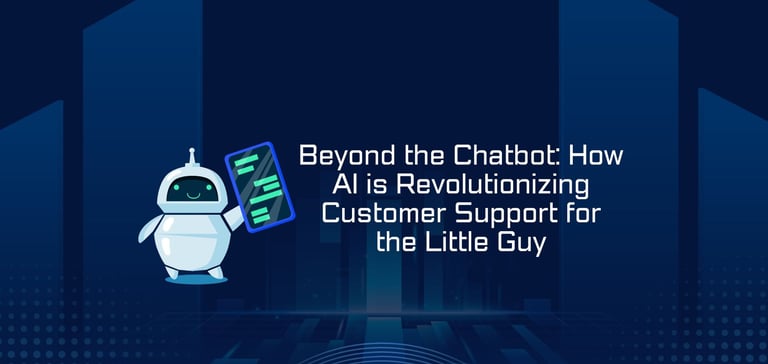Beyond the Chatbot: How AI is Revolutionizing Customer Support for the Little Guy
For decades, exceptional customer support has been the secret weapon of small businesses.
AI BLOGS
editor
8/25/20257 min read


For decades, exceptional customer support has been the secret weapon of small businesses. It’s how they compete with corporate giants who have vast resources, lower prices, and ubiquitous branding. That personal touch, the owner who knows your name, the team that goes the extra mile—these are the hallmarks of a successful local shop or startup.
But this advantage is straining under modern pressure. Customers now demand instant, 24/7 responses. They contact you via email, social media, live chat, and text simultaneously. Your small team is stretched thin, juggling support tickets with product development, marketing, and, you know, actually running the business. The very thing that made you great—personalized attention—is becoming impossible to sustain at scale.
This is where Artificial Intelligence (AI) enters the story. And before you dismiss it as a complex, expensive toy for tech behemoths, think again. Today’s AI is accessible, affordable, and arguably the most powerful tool a small business can adopt to not just protect its customer service edge, but dramatically sharpen it.
This isn't about replacing your team with cold, unfeeling robots. It’s about augmenting your human talent. It’s about giving your team a super-powered assistant that handles the mundane, so they can focus on what humans do best: building genuine, empathetic relationships.
Let’s explore the concrete, practical ways AI can transform your customer support from a constant firefight into a strategic asset.
1. The 24/7 First Responder: AI-Powered Chatbots and Instant Answers
The most obvious and widespread application of AI in support is the chatbot. But forget the clunky, frustrating rule-based bots of yesteryear that left customers screaming “REPRESENTATIVE!” into their keyboards.
Modern AI Education and chatbots, powered by Natural Language Processing (NLP), are different. They can understand intent, context, and nuance. They don’t just match keywords; they understand what a customer is asking for.
How it works for a small business:
You integrate an AI chatbot on your website, Facebook page, or even via SMS. It’s trained on your website content, FAQ documents, past support tickets, and product manuals.
After-Hours Hero: A customer has a question at 10 PM. Instead of waiting 10 hours for your office to open, the AI bot instantly answers their query about your business hours, return policy, or how to reset their password. The customer is happy immediately, and you wake up to a resolved issue, not a frantic message.
Tier-0 Support: The bot handles the most frequent and simple questions: "Where's my order?", "Do you ship to Canada?", "What are your prices for X service?" This might resolve 30-50% of all inquiries without a human ever needing to get involved.
Qualified Lead Generation: For pre-sales questions, the bot can collect crucial information (“What’s your project timeline?” or “How many users do you have?”) and seamlessly hand off a fully-qualified lead to your sales team during business hours.
The Impact: Reduced first-response time to zero seconds, dramatically higher customer satisfaction, and your team spends zero mental energy on repetitive questions.
2. The Intelligent Triage Nurse: Smarter Ticket Routing and Prioritization
When a customer email hits your shared aiopenresource@gmail.com inbox, what happens? Does everyone see it? Does the intern accidentally assign a complex technical question to the marketing intern? Valuable time is lost in this internal confusion.
AI can act as an intelligent dispatcher.
How it works for a small business:
AI tools (often integrated into helpdesk software like Zendesk, Freshdesk, or HubSpot) can automatically read an incoming support request, understand its content and sentiment, and route it to the perfect person.
Skill-Based Routing: An email with the subject “Error code 504 when uploading files” is automatically tagged as Technical and assigned to your developer, Alex. A message saying “I want to cancel my subscription because I’m frustrated” is tagged as “High Priority - Churn Risk” and assigned to your most empathetic account manager, Sarah.
Sentiment Analysis: The AI can detect frustration, anger, or urgency in the language a customer uses. It can then prioritize these tickets, ensuring that a potentially negative experience is defused quickly by putting it at the top of the queue.
Automatic Tagging and Categorization: The AI automatically tags tickets with relevant keywords (e.g., “billing,” “login_issue,” “feature_request”), making it incredibly easy to later pull reports and see what your biggest support headaches are.
The Impact: Faster resolution times, reduced internal friction, and ensuring that sensitive customer issues are handled by the most qualified person, every single time.
3. The Ultimate Knowledge Base Co-Pilot: Smarter Self-Service
Every small business owner knows they should have a comprehensive FAQ or knowledge base. But it’s a pain to create and keep updated. And even when you do, customers often can’t find the exact article they need.
AI transforms your static knowledge base into an interactive, conversational search engine.
How it works for a small business:
You can implement an AI-powered search bar on your help center. Instead of just matching keywords, it uses semantic search to understand the meaning behind a query.
Example: A customer searches for “my payment didn’t go through.” A simple keyword search might bring up an article on “Payment Methods.” An AI-powered search understands this is likely about a “declined credit card” or “failed transaction” and surfaces the precise article titled “What to Do If Your Card is Declined.”
Content Gap Identification: The AI can analyze the questions customers are asking that don’t return good results. It can tell you, “You are getting 15 questions a week about integrating with Shopify, but you have no help article on this.” This gives you a direct content roadmap to reduce future tickets.
The Impact: Customers find answers themselves faster, deflecting even more tickets and empowering users. You also get invaluable data on what information your customers actually need.
4. The Invisible Assistant: AI-Powered Agent Tools
This is where the magic of augmentation truly happens. These are AI tools that work alongside your support agents in the background, making them faster, more consistent, and more knowledgeable.
Canned Response Suggestions: As an agent types a reply, the AI analyzes the ticket and suggests pre-written, high-quality responses that can be inserted and personalized with a single click. This ensures consistency and saves a massive amount of typing time.
Knowledge Base Article Suggestions: While handling a ticket, the AI can instantly surface the most relevant help article from your internal knowledge base, allowing the agent to quickly copy a accurate explanation or simply link the customer to it.
Real-Time Tone and Language Analysis: This is a game-changer. The AI can analyze an agent’s reply before it’s sent and offer suggestions: “This language sounds a bit technical, consider simplifying it,” or “The sentiment of this response is neutral, but the customer is angry—suggest adding a more empathetic phrase.”
Automatic Summarization: After a long, complex chat session, the AI can automatically generate a concise, accurate summary of the interaction, saving the agent 5-10 minutes of note-taking and ensuring the customer record is perfectly clear.
The Impact: Supercharged agent productivity, improved quality and consistency of responses, and reduced handle time. Your team can handle a higher volume of tickets without burning out.
5. The Proactive Strategist: Uncovering Insights from Support Data
Your support inbox is a goldmine of unstructured data. It contains priceless feedback on everything from product flaws and confusing features to unmet customer needs and new market opportunities. Manually sifting through this is impossible for a small team.
AI analytics tools can process thousands of tickets, chats, and emails to find the patterns and insights you’d never see otherwise.
How it works for a small business:
You connect your helpdesk, CRM, and social media to an AI analytics platform (many are now built into affordable helpdesk software).
Identifying Product Issues: The AI can cluster tickets and tell you: “15% of all support requests in the last two weeks are related to the new ‘export feature,’ with the most common problem being a crash on iOS devices.” This gives your product team a precise, data-driven bug report.
Understanding Customer Sentiment Trends: Is overall customer happiness improving or declining? The AI can track sentiment over time and correlate it with product launches, website changes, or pricing updates.
Discovering Feature Requests: The AI can identify and categorize common customer requests. You might discover that “80 mentions of ‘dark mode’ in the last month” making it a no-brainer for your development roadmap.
The Impact: You move from being reactive (putting out fires) to being proactive (preventing fires and building what customers actually want). Support data becomes a strategic input for your entire business.
Getting Started: A Practical Guide for Small Businesses
This all might sound futuristic, but getting started is simpler than you think. You don’t need a team of AI engineers.
Audit Your Pain Points: Where does your support team waste the most time? Is it answering the same questions? Is it routing tickets? Is it writing responses? Start with your biggest headache.
Look for AI-Enabled Tools You Already Use: Check your current helpdesk software (Zendesk, Freshdesk, HubSpot Service Hub, etc.), your CRM (HubSpot, Salesforce), your website chat (Intercom, Drift). They almost certainly have AI add-ons or features already available. Start there.
Start Small and Scale:
Phase 1: Deflection. Implement a simple AI chatbot focused on answering your Top 10 FAQs.
Phase 2: Augmentation. Enable AI-suggested responses and knowledge base articles for your agents.
Phase 3: Insight. After a few months, use AI analytics to review your ticket data and uncover one key insight to act upon.
Choose the Right Vendor: Look for solutions built for SMBs—they prioritize ease of use and affordability. Some great names to investigate include:
Zendesk Answer Bot: For advanced AI chatbots and triage.
Freshdesk Freddy AI: For omnichannel AI across their platform.
Intercom: A leader in conversational AI for support and marketing.
Crisp: Offers a very affordable all-in-one platform with strong AI features.
ManyChat/Drift: Excellent for AI-powered marketing and support on social media and web chat.
Keep the Human in the Loop: This is the most important step. Always design your AI workflow with a seamless handoff to a human. Train your team to use AI as a tool, not a replacement. Their role evolves from answering repetitive questions to handling complex, emotional, and high-value interactions—the work that truly builds loyalty.
The Human Touch: AI as the Enabler, Not the Replacement
The goal of AI in small business customer support is not to create a fully automated, impersonal system. The goal is to remove the friction, the wait times, and the frustration for both the customer and your employees.
By letting AI handle the repetitive and the routine, you free up your talented support staff to do more of the work that matters:
Building personal rapport with loyal customers.
Creatively solving complex, unique problems.
Showing genuine empathy in difficult situations.
Providing the kind of white-glove service that large corporations can only dream of.
AI handles the volume; your team provides the value.
In the end, AI doesn’t erase the small business advantage; it amplifies it. It allows you to scale that “personal touch” that you’re famous for. It lets you be small and personal, yet available and efficient at a scale that rivals the giants. It’s not about becoming more like a big corporation; it’s about using smart technology to be the very best, most responsive, and most customer-centric small business you can be.
The future of small business support isn’t human vs. machine. It’s human with machine. And that’s a partnership that every customer will appreciate.


